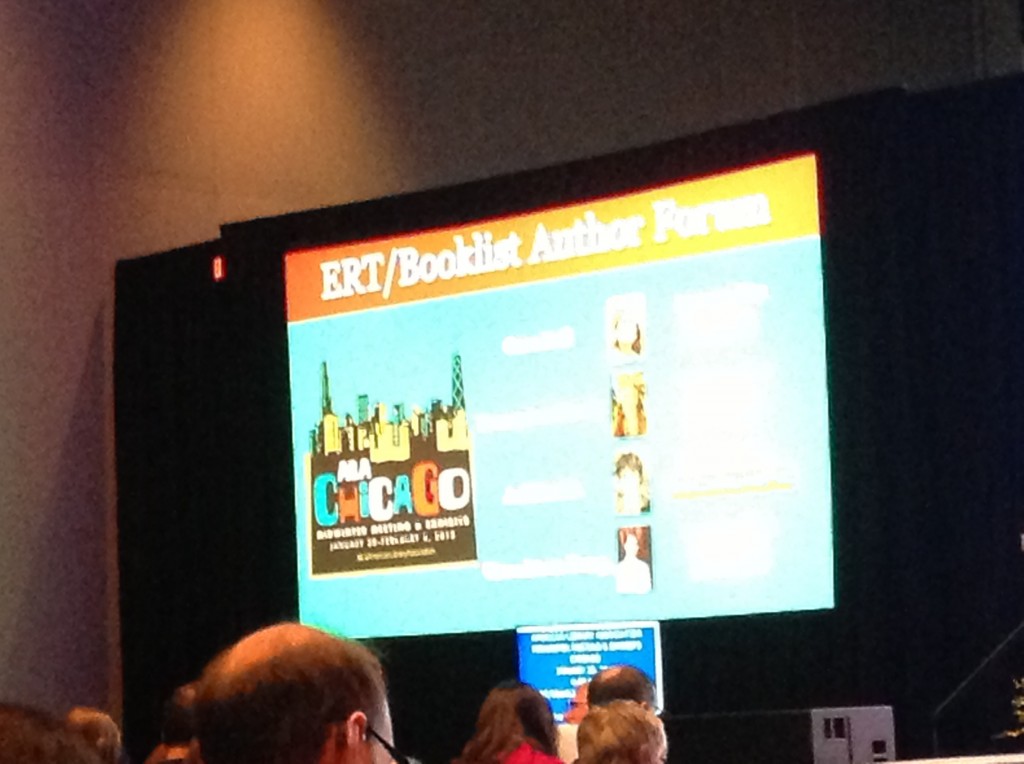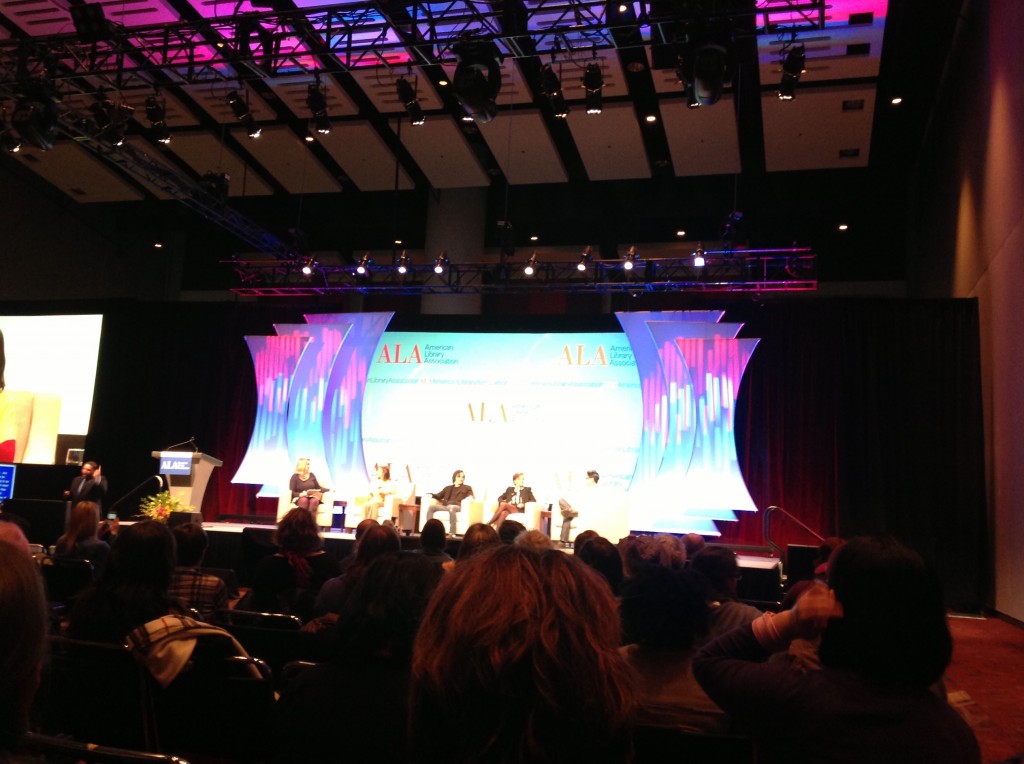Yay! I’m at ALA Midwinter Meeting in Chicago. Tonight I’ve got a cozy night in my hotel room, so my plan is to write up my notes from the sessions I’ve attended so far.
First up was an Author Forum featuring authors of Graphic Novels — Cece Bell, Jeff Smith, Francoise Mouly, and Gene Luen Yang.
I’m going to paste my notes below and try to clean them up:
ERT Booklist Author Forum
Cece Bell, Francoise Mouly, Jeff Smith, Gene Luen Yang
Moderator: How did you start with comics?
CB: When she was 7 or 8. Older brother had National Lampoon. Friend had Beano, from England.
Jeff Smith: Peanuts, Pogo, National Lampoon, MAD Magazine — father read it to him.
Francoise – Grew up in France, where comics were ubiquitous. Magazine Pilot, inspired by MAD.
Gene: Started collecting comics in the 5th grade. Marvel 2 in 1 – Mom made him get Superman instead. The bomb dropped in the comic and captured his imagination. Mostly superhero comics were available then. Did find Bone — proved to him that comics don’t only have to be about superheroes.
What does it mean when someone labels your work “All Ages”?
Francoise: “Little Lit” was labeled for All Ages. She realized later that’s not helpful. Labeling provides guidance, because you can’t tell at a glance what level is appropriate.
Jeff Smith: He doesn’t like that term. He was trying to do a newspaper strip — for everyone. He does a children’s book for adults — “That’s all ages.”
Gene, How do you feel when Middle Schoolers are assigned to read your stuff?
Gene: It’s NUTTY! He started American Born Chinese as pamphlets he copied himself. His own son’s class just did it.
Since he deals with racial stereotypes, he does worry that the kids get it. When he sees middle school teachers leading thoughtful discussions about the issues the book raises, that’s the best case.
Jeff: “How can you make comic books boring?”
We shouldn’t talk them out of comic books by assigning it in school!
Cece, feedback about El Deafo?
Cece: Kids like her are so happy about it. A format they can share with their friends. Also adults, to explain what they go through. It has become a manual, as well as a story of friendship.
A manual so people know how to talk to her!
Response from kids and adults without hearing loss has also been wonderful.
Nicest thing: “I am now meeting people who are like me, wearing hearing aids and lip reading.” When she meets people like that, her world implodes.
Francoise: The abstraction of comics helps pull everyone into the character.
Comics are a young medium, and is opening up.
How do you think comics fit into the movement toward diversity in children’s literature?
Gene: In comics, you can’t hide your character’s diversity.
How do we present cultures that are not necessarily mainstream? That we are not necessarily a part of in an authentic way?
Need to find a balance — not running roughshod over other cultures, but not being afraid to include them.
“We have to be willing to tell stories we are uncomfortable telling.”
Francoise: Cartoonists have been killed for their art. Being brave enough to go there!
As visual people, they go with the essence of things.
A cartoonist has not only the ability, but the duty to bring this to the table.
It’s not like they give the answer. But cartoonists tend to gravitate toward wanting to understand things.
“Cartoonists are in the business of communicating their thoughts.”
If a cartoonist doesn’t communicate, it’s on them.
This is a good medium for exploring diversity.
Comics are very intimate — you see the hand of the author.
The sharing of experience, like Cece mentioned — very vivid and intimate.
Jeff – Hand drawn is extra intimate.
The mixture of the word and picture is dangerous and soupy.
About Charlie Hebdo — the power of the cartoon image is tremendous — but this is a whole new level of messed-up-ness.
Francoise – The issue feels very close to my heart.
Jeff – Francoise has been choosing the New Yorker covers for 21 years. Controversy!
The image completely shook up the whisper campaign that Obama is a Muslim.
Francoise: You can show in a cartoon in a way that really brings it to the front.
That cover got 20,000 insulting letters.
Cogent remark from Candidate Obama: “After all, what is exactly wrong with representing a Muslim in the White House?” Why is that such a shocking image?
The cartoonist can shine a flashlight on issues: Let’s talk about it! Better than hiding things under the rug.
Moderator: Comics in classrooms?
Jeff: Well, I’d make more money.
Certain pieces of information are more effectively communicated visually.
Gene: Comics in Legos, comics in airplanes. Sequential visuals.
There’s a visceral power to the simplified image.
To put an emotion directly in his reader’s gut, he goes with an image.
Cece: A gateway for kids who have trouble reading to start. Deaf kids are already more visual than verbal, and it gives them a headstart.
Visual Literacy: Do you think championing comics as a way to learn visual literacy pigeonholes them?
Jeff — Visual literacy has *always* been a real form of communication.
More images does not mean it’s dumbed down. Visual literacy is incredibly primal to us. Even though he’s talking, he’s still using his hands. Life is visual!
It’s a form of writing that can be as communicative as any other form.
Francoise: Only in the last 25 years have cartoonists thought of themselves as authors — and only the last 10 years that others have.
Some think pictures replace your imagination.
More like poetry and graphic design – both very distilled forms.
Makes for much more sophisticated readers.
Jeff: Unlike a film — director has made timing decisions, more passive.
Comics, like a book, require you to engage and use your imagination.
You have to make them come alive.
Jeff taught himself how to read with Peanuts.
A real thought in those days was that comics caused illiteracy. Even as a kid, he knew that was ridiculous. He knew he was reading. For him, it was absolutely crucial to his imagination and storytelling.
He used his brain to turn it on and discover these real people in comics.
A real imagination-starter.
Cece — You have to fill in what happens in between panels.
Gene — I don’t think of it as a pigeonhole, but as a foothold.
Francoise — We need a vocabulary to talk about visual media.
Moderator: Making comics is difficult. Why are you doing it?
Cece: “I am a terrible descriptive writer.” Being able to tell the story in pictures is a way to get around that.
Being able to use the speech balloons to show what hearing loss is like is so much more immediate than trying to use words to describe it. Allows the reader to experience it right then and there.
Gene loves comics with a pre-logical love. His storytelling voice is in comics.
Jeff – It is indeed a brutal schedule. But that’s only a part of it. The world goes away in that actual moment when you’re creating. A supreme experience, which he loves — like a drug. I get to go there. “That zen thing is why I do it.”
Francoise – She was groomed to be a surgeon. Realized as a teenager she wasn’t going to do that. It helped that her family wasn’t interested in comics. She studied architecture. Was frustrated that your plans are rarely realized. She met Art Spiegelman in NYC. He courted her by reading her comics. She couldn’t believe there was this world of potential hidden in plain sight. She fell in love with him the same time she fell in love with his medium.
Moderator: If you could recommend two books every library should carry, what would they be?
Gene: Usagi Jimbo (a samurai rabbit) By Stan Sakai.
He does his research, so his has lasted.
Meanwhile, by Jason Shiga. Choose your own adventure — Maze and comic combined.
Francoise: (More comics by women are coming out): Castaway on the Letter A, by Fred
Jeff: Hark a Vagrant
Goliath, by Tom G., also, “You’re All Just Jealous of my Jet Pack.”
Cece: Ed Emberley (to create comics) Anybody can draw with these books!
Moomim books
***
After this wonderful panel, I was able to get books signed by the authors featured, and then hit the Exhibits! I managed to restrain myself to 37 books that first night. No, that’s not very good self-restraint.

